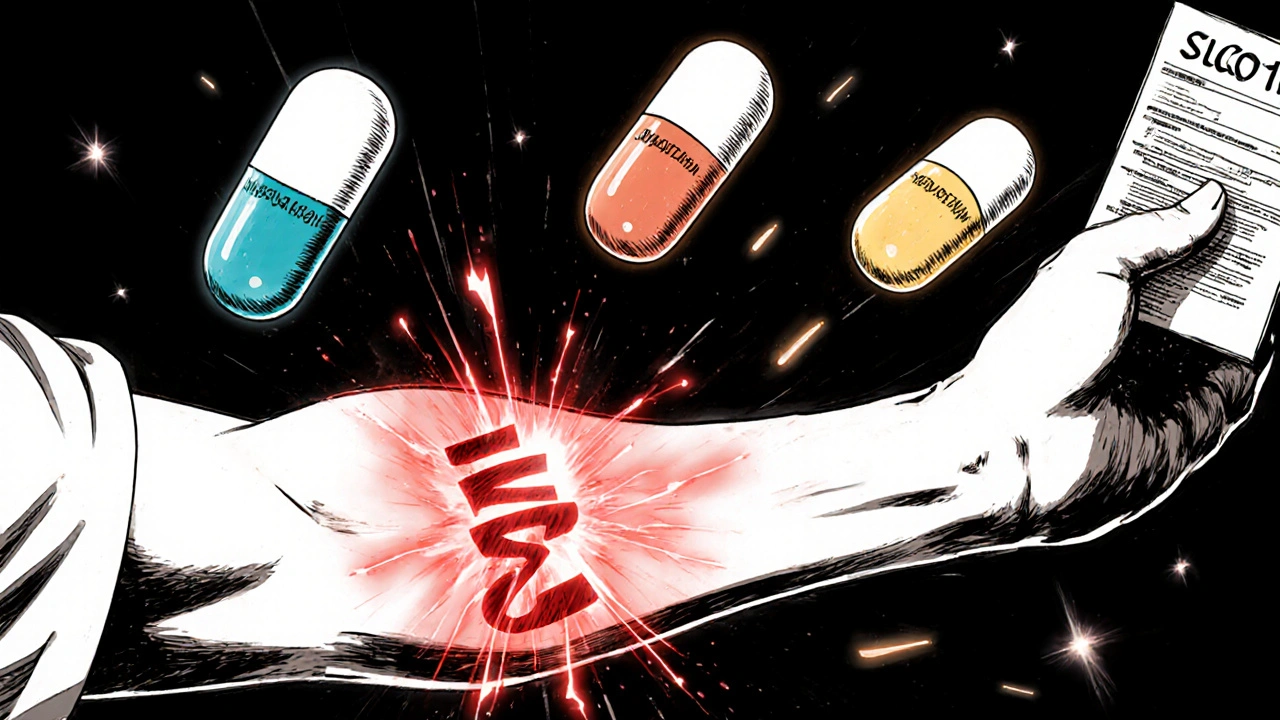Statin Interaction Checker
Check Your Statin Safety
Find out if your statin interacts with other medications you're taking. Select your statin and any other drugs to see potential risks and safer alternatives.
When you're taking a statin to lower your cholesterol, you might not think about the other pills in your medicine cabinet. But the truth is, some medications can turn a safe statin into a serious risk. Not all statins are the same when it comes to drug interactions. Some, like simvastatin and lovastatin, are like ticking time bombs when mixed with common drugs. Others, like pravastatin and rosuvastatin, are far more forgiving. Knowing which is which isn’t just helpful-it can prevent muscle damage, hospital visits, or worse.
Why Statin Interactions Matter More Than You Think
Statins are among the most prescribed drugs in the world. In the U.S. alone, over 32 million people take them. They cut heart attacks and strokes by lowering LDL cholesterol by 30% to 60%. But with so many people on multiple medications-blood pressure pills, antibiotics, even over-the-counter supplements-the chance of a bad interaction is real. The biggest danger? Rhabdomyolysis. That’s when muscle tissue breaks down, spilling proteins into the bloodstream that can wreck your kidneys. It’s rare, but it happens. And it’s often avoidable if you know which statin to pick and which drugs to avoid.How Statins Are Metabolized: The Key to Understanding Interactions
Not all statins work the same way inside your body. Their fate depends on two main systems: the liver’s CYP450 enzymes and the OATP1B1 transporter. Five statins-atorvastatin, simvastatin, lovastatin, fluvastatin, and the now-withdrawn cerivastatin-rely heavily on CYP enzymes to break down. Among these, simvastatin, lovastatin, and atorvastatin are mainly handled by CYP3A4. That’s the same enzyme that processes grapefruit juice, antibiotics like clarithromycin, and HIV drugs like ritonavir. When these drugs block CYP3A4, statin levels in your blood can spike. For simvastatin, clarithromycin can raise exposure by 10 times. For lovastatin? Up to 16 times. Fluvastatin is different. It’s mostly broken down by CYP2C9. That means drugs like warfarin or phenytoin can interfere, but not the same ones that mess with simvastatin. Then there are the statins that barely touch CYP enzymes at all: pravastatin, rosuvastatin, and pitavastatin. These are cleared mostly by the kidneys or through glucuronidation. That makes them much safer when you’re on other meds. Pravastatin, in particular, is excreted unchanged by the kidneys. No liver metabolism means fewer chances for interference.Top 3 Dangerous Combinations and Which Statins to Avoid
Some drug pairs are absolute no-go zones. Here are the most dangerous ones and which statins to steer clear of.- Cyclosporine (used after organ transplants): This drug blocks the OATP1B1 transporter, which helps move statins out of your liver. Without it, statins build up dangerously. Cyclosporine increases pitavastatin levels by 7.1 times and rosuvastatin by 4.9 times. The FDA explicitly bans combining cyclosporine with simvastatin, lovastatin, and pitavastatin. Pravastatin is the only statin approved for use with cyclosporine at doses up to 40 mg daily.
- Clarithromycin and erythromycin (antibiotics): These are strong CYP3A4 inhibitors. Simvastatin and lovastatin are the worst offenders here. Even a 5-day course can push simvastatin levels into toxic range. Atorvastatin is less risky, but still needs caution. Rosuvastatin and pravastatin? Generally safe.
- Gemfibrozil (a fibrate for triglycerides): This drug doesn’t just inhibit CYP2C8-it also blocks glucuronidation, a backup way some statins leave the body. Gemfibrozil can double statin levels. The risk is highest with simvastatin and lovastatin. Fenofibrate, another fibrate, doesn’t have this effect. If you need both a fibrate and a statin, fenofibrate is the safer choice.

Statins Ranked by Interaction Risk
Here’s how the seven statins stack up when it comes to drug interactions, from highest to lowest risk:| Statin | Main Metabolism Pathway | Key Interaction Risks | Safe Alternatives |
|---|---|---|---|
| Simvastatin | CYP3A4 | Clarithromycin, cyclosporine, grapefruit juice, diltiazem, verapamil, gemfibrozil | Pravastatin, rosuvastatin |
| Lovastatin | CYP3A4 | Same as simvastatin-highest risk with HIV drugs and antifungals | Pravastatin, rosuvastatin |
| Atorvastatin | CYP3A4 + OATP1B1 | Clarithromycin, cyclosporine, diltiazem, some HIV meds | Pravastatin, rosuvastatin |
| Fluvastatin | CYP2C9 | Warfarin, phenytoin, fluconazole | Pravastatin, rosuvastatin |
| Pitavastatin | Glucuronidation + minor CYP2C9 | Cyclosporine (very high risk), gemfibrozil | Pravastatin, rosuvastatin |
| Rosuvastatin | OATP1B1 + minor CYP2C9 | Cyclosporine, gemfibrozil (mild), ciprofloxacin | Pravastatin |
| Pravastatin | Renal excretion (minimal CYP) | Very low risk. Only caution with high-dose cyclosporine (max 40 mg/day) | N/A-lowest risk |
What About Ticagrelor, Diltiazem, and Colchicine?
Ticagrelor (Brilinta), used after heart attacks, was once thought to be risky with statins. But newer data shows it only slightly increases atorvastatin levels-so it’s generally safe. The American College of Cardiology says you can use atorvastatin with ticagrelor without dose changes. Diltiazem and verapamil (blood pressure drugs) are CYP3A4 inhibitors. They can raise simvastatin and lovastatin levels by 3 to 8 times. Even atorvastatin can be affected. If you’re on one of these, avoid simvastatin entirely. Lovastatin should stay under 40 mg. Atorvastatin can be used, but start low and monitor. Colchicine, used for gout, is another concern. It can increase muscle toxicity risk when combined with statins. You don’t need to stop the statin, but your doctor should lower the dose and watch for muscle pain. Rosuvastatin and pravastatin are preferred here.Genetics Can Change Everything
Your genes matter. A common variation in the SLCO1B1 gene-called the c.521T>C polymorphism-makes it harder for your body to clear certain statins. People with this variant have a 4.5 times higher risk of muscle damage from simvastatin. It’s less of a problem with pravastatin and rosuvastatin. The FDA added this genetic info to simvastatin’s label in 2011. Some hospitals now test for it before prescribing. If you’ve had unexplained muscle pain on a statin, ask your doctor about genetic testing. It might explain why one statin didn’t work for you-and why another might.
What Should You Do?
If you’re on a statin and take other meds, here’s what to do:- Make a full list of every medication, supplement, and herb you take-including OTC drugs like ibuprofen or melatonin.
- Ask your pharmacist or doctor: "Which of my drugs could interact with my statin?" Don’t assume they know.
- If you’re on cyclosporine, HIV meds, or antibiotics like clarithromycin, ask if your statin is safe.
- Never start a new drug without checking its interaction profile with your statin.
- If you feel unexplained muscle pain, weakness, or dark urine, stop the statin and call your doctor immediately.
When to Switch Statins
You don’t have to stay on a risky statin. If you’re on simvastatin or lovastatin and take even one interacting drug, switching is smart. Pravastatin and rosuvastatin are the safest bets for people on multiple medications. Pitavastatin is good too-but avoid it with cyclosporine. Atorvastatin is a middle ground. It’s effective and can be used with many drugs if monitored. But if you’re on several interacting meds, go for pravastatin or rosuvastatin.The Bottom Line
Statins save lives. But not all statins are created equal when it comes to drug interactions. Simvastatin and lovastatin carry the highest risk. Atorvastatin and fluvastatin are moderate. Pravastatin and rosuvastatin are the safest for people on multiple medications. Your goal isn’t just to lower cholesterol. It’s to do it without putting your muscles-or your kidneys-at risk. Talk to your doctor. Know your meds. Choose wisely. The right statin for you isn’t just about effectiveness. It’s about safety.Can I drink grapefruit juice with my statin?
No-not if you’re taking simvastatin, lovastatin, or atorvastatin. Grapefruit juice blocks the CYP3A4 enzyme, which can cause these statins to build up to dangerous levels in your blood. Even one glass a day can increase the risk of muscle damage. Pravastatin, rosuvastatin, and fluvastatin are not affected by grapefruit juice and are safe to take with it.
Is pravastatin the safest statin overall?
For people on multiple medications, yes. Pravastatin is metabolized mainly by the kidneys, not the liver’s CYP enzymes. It has the lowest risk of drug interactions among all statins. It’s the only statin approved for use with cyclosporine at standard doses. It’s also not affected by grapefruit juice or most antibiotics. However, if you have kidney problems, your doctor may choose another option.
Why is simvastatin 80 mg no longer recommended?
The FDA and American Heart Association no longer recommend simvastatin 80 mg because the risk of severe muscle damage (rhabdomyolysis) is too high, even without other interacting drugs. Studies showed no extra heart benefit at that dose compared to 40 mg, but the risk doubled. If you’re on 80 mg, talk to your doctor about switching to a safer statin or lowering the dose.
Can I take a fibrate with my statin?
Yes, but only with the right combination. Gemfibrozil increases statin levels and raises the risk of muscle damage. Avoid it with all statins except pravastatin. Fenofibrate is much safer and doesn’t interfere with statin metabolism. If you need both a fibrate and a statin, fenofibrate is the preferred choice.
Do I need blood tests if I’m on a statin?
Yes. Your doctor should check your liver enzymes before you start and then every few months, especially if you’re on a high-risk statin or taking interacting drugs. You should also report any muscle pain, weakness, or dark urine right away. A simple blood test for creatine kinase can catch early signs of muscle damage before it becomes serious.
Future options like bempedoic acid (Nexletol) are emerging with almost no drug interaction risk, offering hope for patients who can’t tolerate statins. But for now, choosing the right statin-and knowing what not to mix it with-is still the best way to protect your heart without putting your body at risk.


swatantra kumar
November 20 2025So basically if you’re on meds, your statin is basically a Russian roulette with muscle breakdown? 🤯 I’m just glad I switched to rosuvastatin after my cousin ended up in the ICU from simvastatin + clarithromycin. Doc didn’t even check his other pills. Wild.
Also, grapefruit juice? Bro, I drink it every morning. Guess I’m lucky I’m on pravastatin. 🍊💪